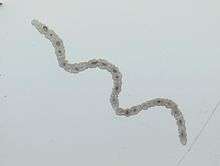Catenulida
Catenulida is an order of flatworms in the classical classification, or a class of flatworms in a phylogenetic approach.[2] They are relatively small free-living flatworms, inhabiting freshwater and marine environments. There are about 100 species described worldwide, but the simple anatomy makes species distinction problematic.[2]
| Catenulida | |
|---|---|
 | |
| Catenula lemnae | |
| Scientific classification | |
| Kingdom: | Animalia |
| Phylum: | Platyhelminthes |
| Class: | Catenulida Meixner, 1924[1] |
| Families | |
| Synonyms | |
|
Notandropora Reisinger, 1924 | |
Description
The anatomy of catenulids is simple and lacks hard parts. The mouth is located anteriorly and connects to a simple pharynx and a simple intestine that forms a ciliated sac. They possess two pairs of nerve cords and often a statocyst, as well as a single protonephridium.[2]
The gonads are unpaired. Unusually, the male gonopore opens on the dorsal surface of the animal, above the pharynx, while the female reproductive system lacks any of the usual ducts and related structures found in other flatworms. The sperm is nonmobile and lacks flagella or cilia.[2] Asexual reproduction by paratomy is common, and it usually leads to a chain of organisms (zooids), hence the name, from Latin catenula, small chain.[2]
Members of the symbiotic genus Paracatenula lack a digestive tract, and instead harbor intracellular chemoautotrophic bacterial symbionts that are assumed to provide their nutrition.[3][4]
Ecology
All catenulids are aquatic, benthic animals. Most of them live in freshwater, being usually very abundant in mires, ponds, streams and moist terrestrial habitats. A small number of species are known to live in the sea.[5]
The diet of most catenulids consists of small invertebrates and algae that they capture from the water column.[6] Others, such as those of the genus Paracatenula use chemoautotrophic bacterial symbionts that live inside their cells as a food source.[3]
Phylogeny
The monophyly of Catenulida is supported by molecular studies and by at least 3 synapomorphies: the unpaired protonephridium, the unpaired and anterodorsally located testis and the nonmobile sperm.[7]
Although there are no known synapomorphies connecting Catenulida to other flatworms (Rhabditophora), molecular studies indicate that they are sister-groups. All characters common to both clades, such as the internal fertilization and the simple gut with a single opening, are found in other groups as well.[2]
References
- Artois, T.; Tyler, S. (2015). Catenulida. In: Tyler, S., Artois, T.; Schilling, S.; Hooge, M.; Bush, L.F. (eds) (2006-2017). World list of Platyhelminthes. Accessed through: World Register of Marine Species at on 2017-02-14
- Larsson, K.; Jondelius, U. (2008). "Phylogeny of the Catenulida and support for Platyhelminthes". Organisms Diversity & Evolution. 8 (5): 378–387. doi:10.1016/j.ode.2008.09.002.
- Leisch, N.; Dirks, U.; Gruber-Vodicka, H. R.; Schmid, M.; Sterrer, W.; Ott, J. A. (2011). "Microanatomy of the trophosome region of Paracatenula cf. polyhymnia (Catenulida, Platyhelminthes) and its intracellular symbionts". Zoomorphology. 130 (4): 261–271. doi:10.1007/s00435-011-0135-y. PMC 3213344. PMID 22131640.
- Gruber-Vodicka, H. R.; Dirks, U.; Leisch, N.; Baranyi, C.; Stoecker, K.; Bulgheresi, S.; Heindl, N. R.; Horn, M.; Lott, C.; Loy, A.; Wagner, M.; Ott, J. (27 June 2011). "Paracatenula, an ancient symbiosis between thiotrophic Alphaproteobacteria and catenulid flatworms". Proceedings of the National Academy of Sciences. 108 (29): 12078–12083. doi:10.1073/pnas.1105347108. PMC 3141929. PMID 21709249.
- Larsson, K.; Ahmadzadeh, A.; Jondelius, U. (2008). "DNA taxonomy of Swedish Catenulida (Platyhelminthes) and a phylogenetic framework for catenulid classification". Organisms Diversity & Evolution. 8 (5): 399–412. doi:10.1016/j.ode.2008.09.003. ISSN 1439-6092.

- Núñez-Ortiz, Alma R.; Nandini, Sarma; Nandini, S.S.S. (2016). "Demography and feeding behavior of Stenostomum leucops (Dugés, 1828)". Journal of Limnology. 75 (s1): 48–55. doi:10.4081/jlimnol.2016.1369. ISSN 1723-8633.

- Boll, Piter Kehoma; Rossi, Ilana; Amaral, Silvana Vargas do; Oliveira, Simone Machado de; Müller, Eliara Solange; Lemos, Virginia Silva; Leal-Zanchet, Ana Maria (2013). "Platyhelminthes ou apenas semelhantes a Platyhelminthes? Relações filogenéticas dos principais grupos de turbelários". Neotropical Biology and Conservation (in Portuguese). 8 (1). doi:10.4013/nbc.2013.81.06. ISSN 2236-3777.
